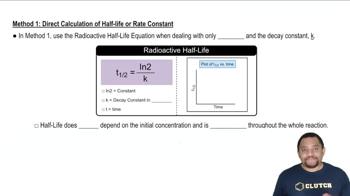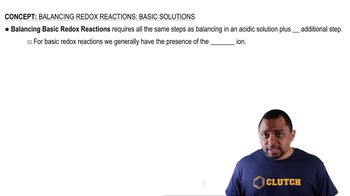Complete and balance the following half-reactions. In each case, indicate whether the half-reaction is an oxidation or a reduction. (a) Sn2+(aq) → Sn4+(aq) (acidic solution) (b) TiO2(s) → Ti2+(aq) (acidic solution) (c) ClO3-(aq) → Cl-(aq) (acidic solution) (d) N2(g) → NH4+(aq) (acidic solution)

Complete and balance the following half-reactions in basic solution. In each case, indicate whether the half-reaction is an oxidation or a reduction.
a. O2(𝑔)⟶H2O(𝑙)
b. Mn2+(𝑎𝑞)⟶MnO2(𝑠)
c. Cr(OH)3(𝑠)⟶CrO42−(𝑎𝑞)
d. N2H4(𝑎𝑞)⟶N2(𝑔)
 Verified step by step guidance
Verified step by step guidance
Verified video answer for a similar problem:
Key Concepts
Half-Reaction Method

Oxidation and Reduction

Basic Solution Conditions

Complete and balance the following half-reactions in basic solution. In each case, indicate whether the half-reaction is an oxidation or a reduction.
a. OH−(𝑎𝑞)⟶O2(𝑔)
b. SO32−(𝑎𝑞)⟶SO42−(𝑎𝑞)
c. N2(𝑔)⟶NH3(𝑔)
d. HO2−(𝑎𝑞)⟶OH−(𝑎𝑞)
Complete and balance the following half-reactions. In each case, indicate whether the half-reaction is an oxidation or a reduction. (f) SO32-1aq2 ¡ SO42-1aq2 (basic solution)
Complete and balance the following half-reactions in basic solution. In each case, indicate whether the half-reaction is an oxidation or a reduction. c. Cr(OH)3(𝑠)⟶CrO42−(𝑎𝑞)
Complete and balance the following half-reactions in acidic solution. In each case indicate whether the half-reaction is an oxidation or a reduction. b. H2SO3(𝑎𝑞)⟶SO42−(𝑎𝑞)
Complete and balance the following equations, and identify the oxidizing and reducing agents: (a) Cr2O72-(aq) + I-(aq) → Cr3+(aq) + IO3-(aq) (acidic solution) (b) MnO4-(aq) + CH3O(1aq) → Mn2+(aq) + HCOOH(aq) (acidic solution) (c) I2(s) + OCl-(aq) → IO3-(aq) + Cl-(aq) (acidic solution)
